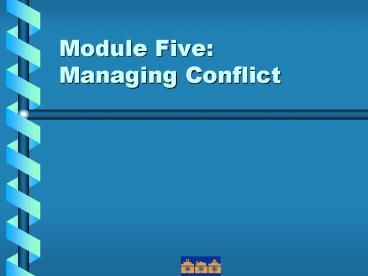Module Five: Managing Conflict - PowerPoint PPT Presentation
1 / 23
Title:
Module Five: Managing Conflict
Description:
The challenge to leaders is to manage conflict so that it is a constructive, ... Roger Fisher, William Ury, and Bruce Patten, eds. ... – PowerPoint PPT presentation
Number of Views:155
Avg rating:3.0/5.0
Title: Module Five: Managing Conflict
1
Module Five Managing Conflict
2
Managing Conflict
Inevitable fact of life People dont always
agree! Conflict Normal part of working in
groups The challenge to leaders is to manage
conflict so that it is a constructive, rather
than a destructive force.
3
Objectives
- To recognize conflict and learn about its causes.
- To look at conflict as an integral part of making
decisions. - To develop strategies to manage conflict and to
move forward with group work.
4
Guiding Questions
- How can we make conflict work for us instead of
against us? - What strategies will help us work through
conflict? - What happens if we cant reach consensus?
5
Human Continuum
Disagree
Agree
- Never assume there is agreement or consensus
the continuum illustrates that. - Some people have strong opinions and gravitate to
the extremes. - Some people see both sides and stand in the
middle. - People may stand by the same number for very
different reasons.
6
Debriefing of Activity
- What are the implications when members of a group
feel differently about conflict and the role it
plays in the community work?
7
4 Types of Conflict
- Between Individuals
- Over Goals
- Over Strategies for reaching the goal
- Over Competition for resources
8
Negative Conflict Can . . .
- Create Distrust
- Disrupt cooperation
- Divert us from our goals
9
Positive Conflict Can . . .
- Help define issues
- Introduce new perspectives
- Make groups consider a wide range of options
- Energize creative thinking
- Keep groups alert to members interests
10
Stories of Positive Conflict
- Share a story from your life when conflict
resulted in something positive. - Report to the larger group. Do not retell
stories. Focus on the ways that conflict can
ultimately be a creative and positive force.
11
Different values can escalate into Conflict,
especially if the stakes are high!
12
Conflict Analysis Activity Root Causes
- Focus conversation on a recent community
conflict. - Members call out a possible cause of the
conflict. - One member writes each response on an index card.
- Share and categorize responses.
- (see Handout 1)
13
Causes of Conflict
- Competition for limited resources
- Communication problems
- Different interests and goals
- Different perceptions and attitudes
- Lack of clarity
14
Making Group Decisions
- Autocratic one person decides for group
- The Few few (experts) decide for group
- Majority Rule group votes most votes wins
- Consensus Building based on communication
compromise
15
Making Group Decisions (Majority Rule vs.
Consensus)
- Working to Build Consensus . . .
- Encourages people to work together
- Acknowledges self-interests
- Sets up a problem solving framework
16
Conflict Resolution Strategies
Avoidance ignore it it will go away
Diffusion address symptoms, not root Power
Intervention overpower those who disagree
Negotiation seek resolution together
17
Managing Conflict to Make Decisions
- Think of a specific situation that has resulted
in conflict in your community. - Apply each of the strategies listed.
- Record the answers to the questions listed.
- Report group findings
18
Conflict to Consensus
- Acknowledge that conflict exists.
- Identify the root causes of the problem you are
addressing. - Identify common concerns and shared values.
19
Perception is reality!
Box exercise
20
Techniques for Conflict Resolution
People separate the people from the
problem Interests focus on interests, not
positions Options generate variety of
possibilities, not a single answer Criteria
judge results on objective standards, not one
groups values beliefs Roger Fisher, William
Ury, and Bruce Patten, eds. Getting to Yes
Negotiating Agreement Without Giving In. (New
York, NY Penguin Books, 1981, 1991) pp. 10-11
21
Modified Consensus Decision Making Activity
- Choose one idea group would consider adopting
- Originator serves as leader brainstorm
suggestions to strengthen idea - Check with originator if suggestions are added,
is integrity of the original idea maintained? - Test for consensus use voting scale
22
Working Toward Consensus
- Fist to Five Test
- Wholeheartedly agree
- Supportive
- Can live with it
- Reservations need more talk
- Reject it
23
Objectives Revisited
- To recognize conflict and learn about its causes.
- To look at conflict as an integral part of making
decisions. - To develop strategies to manage conflict and to
move forward with group work.































